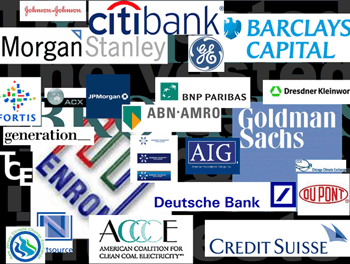Clinton campaign says carbon tax not out of the question
…Climate change is potentially a $7 Trillion dollar money making venture — for bankers
The tide of money, the vested interests flows
 H/t to Eric Worrall at WattsUp.
H/t to Eric Worrall at WattsUp.
The current “green” industry is already around $1.5 Trillion a year. Mark Carney, the Governor of the Bank of England said he expects this to grow to $5-7 trillion.
Financial Post: Climate change a $7 trillion funding opportunity
He said that given the enormous funding needs for clean infrastructure — he estimates at somewhere between $5 trillion and $7 trillion a year — investment opportunities will rebound.
If clean green energy was efficient, cheap and reliable there would be no “funding need” as the market would leap to exploit that opportunity. Instead most leadinginvestors act like they are skeptics. The fact that central bankers are selling it so aggressively says a lot. Perhaps central bankers want to help the poor and save the world, or could it be that the entire financial industry will profit from a fake, forced market and another fiat currency? What are the brokerage fees on a $7T market…
Again we get this “free market” myth:
[Carbon pricing is the cleanest way for markets to judge the tangible exposure to climate change,” said Carney
Carbon pricing has failed to change the weather all over the world. Free markets don’t work when they aren’t free and when they apply to a ubiquitous molecule involved in almost every life form on the planet. And what does “clean pricing” mean anyway? The cost benefit assessment of using solar panels to reduce your exposure to flood damage in 2100 is as filthy-dirty-a-calculation as anything gets. Calculations don’t get messier, blacker or more pointless than this. Crunch those numbers and then bury them in 6 feet of volcanic ash.
The idea of slapping a market onto a product that is mostly produced and consumed by nature is bizarre in the extreme. Almost none of players in a global carbon market will respond to the incentives on offer. The Pacific Ocean won’t buy a credit, and nor will phytoplankton, cows, sheep or yeast. Even in the 4% of the market controlled by humans, demand is “inelastic”, meaning the costs of energy already force most of the market to be efficient. The gains that are left are minor, pathetic creeping improvements. So sweeping, economy wide measures are inefficient, even if the IPCC models weren’t broken.
Though it’s not 100% clear whether Carney meant “annually” or …
Florida County Commissioners Propose new Climate Doomsday Property Tax
…Cheers! ‘Carbon markets in US, Europe & Asia are collapsing, with prices so low they’ve become virtually valueless’
LONDON, July 8 — Carbon markets, the free-enterprise solution to saving the world from global warming, are now in danger themselves.
The idea was simple enough: Set a cap on carbon emissions, issue enough permits to allow power plants, refineries and the like to stay within those limits and then shrink the cap over time to achieve reductions. The companies whose emissions fall fastest can sell their permits for a profit to slower responders — call it a reward for good behaviour.
The reality, though, is more complex. Undercut by a lack of political will on the size of caps and overtaken by costly new environmental mandates, carbon markets in the US, Europe and Asia are collapsing, with prices so low they’ve become virtually valueless. The credits auctioned in the US Northeast in June, for instance, sold for just US$4.53 (RM18.27) a short tonne, a 40 per cent drop from December.
“Climate policy has been muddled and messy,” said Michael Grubb, a professor at University College London’s Institute for Sustainable Resources who has advised the UK energy regulator. “Governments have set inadequate targets due to lobbying pressures and because they didn’t think carefully enough about overlapping efforts. That has destroyed investor confidence that carbon prices will rise.”
The idea of a carbon market originated 20 years ago with Richard Sandor, an economist who also pioneered interest-rate futures and derivatives at the Chicago Board of Trade. Today, there are 38 countries, cities, states and provinces using pricing systems in an attempt to put a lid on greenhouse gases, according to the World Bank.
The problem is that the permits are selling at a slower and slower rate. The surplus of allowances is becoming so large in systems run by Europe, California and Quebec — which together account for more than 90 per cent of global trading — that by 2022 it could cover the emissions spewing from every car on Earth for a full year, according to estimates by the London environmental group Sandbag Climate Campaign CIC and Bloomberg New Energy Finance.
In California’s market, all 23 million allowances sold in an auction in 2014. In May, 7.3 million permits found buyers, only 11 per cent of what was put up for sale.
– See more at: http://www.themalaymailonline.com/money/article/tough-task-to-prevent-global-warming-when-carbon-is-this-cheap#sthash.EwchrFQQ.dpuf…
Cool Futures: World first hedge fund aims to pop the climate-bubble
Cool Futures: World first hedge fund aims to pop the climate-bubble
Time to pop some bubbles There is a $1.5 Trillion industry selling us better weather. If this climate money bubble were to collapse, someone is going to make a motza-lot of money. (And it might as well be the skeptics who saw it coming, eh?) Would you like to help develop a hedge fund that can play that game, and take those bets, both to invest and divest, to hedge, donate, and fund research? Another task is to also grow a philanthropic hedge fund management company.* One day soon, you may like the idea of short-selling overvalued renewables stocks, and doing other things that profit from cooler weather or collapsing subsidies — but which fund could you invest in to manage that? It’s a niche crying out to be filled. David and I liked this idea so much when we were approached by Chris Dawson two years ago, we got involved in developing Cool Futures (and obviously stand to benefit if this comes together, see the Disclosure at the end). Cool Futures could change the game in so many ways. The vision here is much more than just profit making. It’s about being a […]Rating: 10.0/10 (1 vote cast)
— gReader Pro…
Trump Vows To Nix Paris Climate Treaty
…Report: Trump’s climate skeptic energy adviser believes there should be a carbon tax
…Warmists love $500 million sea level rise tax – ‘extremely forward-thinking solution’ – San Fran Area Residents Will Soon Decide Whether To Fund Sea Level Rise Adaptation With A Tax
The state of California has done a lot to address climate change, he said, but so far its efforts to adapt to climate change haven’t quite caught up to its efforts to mitigate it. That’s where initiatives like this come in. “There are a lot of things happening in state capital right now on adaptation … [the state] is incredibly proactive, but frankly, budgets are tight,” he said.…
EPA Head Says Obama May Want To Create New Carbon Tax, But Her Regs Do Just Fine
EPA Head Says Obama May Want To Create New Carbon Tax, But Her Regs Do Just Fine
http://dailycaller.com/2016/05/07/epa-chief-says-climate-regs-were-meant-to-be-a-type-of-carbon-tax/
‘There are many ways you can place a price on carbon, I think regulation is one of them’
— gReader Pro…

